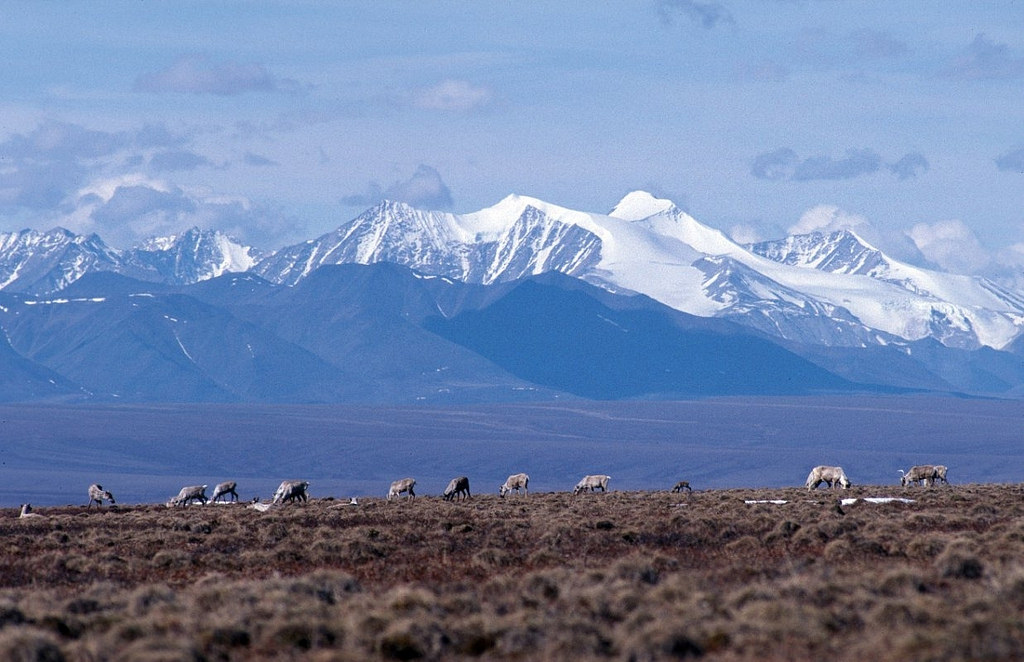Company drops plan for an aerial geological survey of Alaska’s Arctic refuge
The move came after U.S. Fish and Wildlife officials warned that the overflights could pose serious risks to wildlife and Alaska Native subsistence hunting.

An aerial survey intended to gather geologic data in the coastal plain of the Arctic National Wildlife Refuge will not be conducted this summer.
CGG Canada Services Ltd., a division of the French-based geophysical firm CGG, had proposed doing the survey to gather information aimed at helping companies assess oil potential in the region where the Trump administration intends to hold a lease sale by year’s end. But CGG has dropped its plan, a company spokesman told the New York Times.
When contacted by ArcticToday, CGG declined to comment.
The plan was abandoned shortly after the U.S. Fish and Wildlife Service advised the company that its plans to fly low-altitude transects over the refuge could disturb polar bears, caribou, migratory birds and that Alaska Native subsistence food-gathering activities could also be disrupted.
In a June 7 letter to CGG’s Canada project manager, the Fish and Wildlife Service said the company should obtain a special permit allowing it to disturb polar bears. After evaluating the company’s plan for repeat flights at elevations as low as 500 feet, with only 1,600 feet of space between transects, the service concluded that “the potential to take polar bears incidental to your proposed activities is high enough that it cannot be discounted,” the letter said. “Take” of protected marine mammals encompasses any disturbance, ranging from disruption of travel to animals’ death. An incidental-take authorization would make those disturbances legal; disturbances caused when there is no authorization in place would violate the Marine Mammal Protection Act.
The Fish and Wildlife Service letter also advised CGG to coordinate with refuge staff to avoid disturbances to birds and to reach out to the Kaktovik community to avoid disruptions of Inupiat residents’ hunting and fishing activities.
The Fish and Wildlife Service letter reflected concerns raised by environmentalists and discussed with agency officials, said Bridget Psarianos, a staff attorney with the environmental law firm Trustees for Alaska.
“The importance of the coastal plain for polar bears can’t be overstated,” Psarianos said. “We had a lot of concern about the company going out there and conducting these aerial surveys that had the potential to harass and take polar bears.”
While Trustees and other environmentalists are happy that CGG will not be doing the aerial work this summer, that does not preclude others from something similar, Psarianos said. “I think we’re going to keep our eyes to the ground to see if any other companies are doing the same thing,” she said.
Even though she and others believe any company trying to conduct such flights should get an incidental-take authorization, no federal permits are required for overflights of the refuge coastal plain, she noted.
The CGG aerial survey was proposed after a more thorough attempt to gather geologic information stalled.
A plan for an on-the-ground 3D seismic survey has been submitted by SAExploration and two Native corporate partners, Arctic Slope Regional Corp. and the Kaktovik Inupiat Corp. That survey program would send “thumper” vehicles across the landscape to shoot sound waves down into the earth. The technology is intended to map out geologic structures. On the North Slope, such programs are conducted in winter.
SAExploration’s application to the Bureau of Land Management, the Department of the Interior Agency responsible for the ANWR oil-development program, proposed a December 2018 startup. But the plan has yet to be cleared by the Fish and Wildlife Service. The service has raised concerns about the seismic activities disturbing denning polar bears. As sea ice retreats, more polar bears are coming to land, and the refuge’s coastal plain is an increasingly important area for maternal polar bears who dig dens in the snow to give birth to and raise their young in the winter and spring.
Seismic operations could force mother bears out of the dens, leaving the cubs abandoned and at risk of death, critics of the SAExploration plan said. Seismic vehicles could even crush dens, killing the cubs inside, Steve Amstrup, chief scientist for Polar Bears International, said in his evaluation of the SAExploration plan.
Aside from the risks to polar bears, there are several other dangers posed by the seismic plan, including likely damage to ice-rich permafrost, likelihood of extreme damage to the tundra and the Arctic hydrological system and disturbances to other Arctic animals, a team of veteran University of Alaska Fairbanks scientists said in a white paper.
As of early July, there had been no new development in SAExporation’s seismic application, said Lesli Ellis-Wouters, a BLM spokeswoman in Anchorage.
The BLM also had no information on the cancellation of CGG’s plans, Ellis-Wouters said. Because CGG did not need any permission from the BLM to conduct the flights, the agency has not been directly involved in the planning, she said.